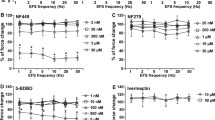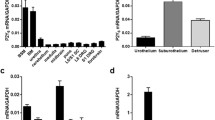Abstract
P2Y6 receptor in bladder smooth muscle responds to UDP by increasing muscle tone and augmenting bladder contractions. The exact cellular location of the receptor is however unknown. Three commercially available antibodies to P2Y6 receptor gave clean bands on Western blot which were eliminated by specific peptide competition. Two of the three also immunostained bladder smooth muscle cells while leaving adjacent interstitial cells of Cajal unstained. However, attempts to validate the specificity of these antibodies by performing the same assays on bladders from P2Y6 knockout mice were unsuccessful. In Western blots, all three antibodies bound similar proteins in both wild type and P2Y6 knockout tissue. Immunostaining of knockout tissue sections also showed no difference in staining patterns or intensity. We conclude that rigorous controls are required when using commercial reagents to this G-protein coupled receptor and perhaps to other members of the P2Y receptor family.





Similar content being viewed by others
References
Adams MN, Pagel CN, Mackie EJ, Hooper JD (2012) Evaluation of antibodies directed against human protease-activated receptor-2. Naunyn Schmiedebergs Arch Pharmacol 385:861–873
Bar I, Guns PJ, Metallo J, Cammarata D, Wilkin F, Boeynams JM, Bult H, Robaye B (2008) Knockout mice reveal a role for P2Y6 receptor in macrophages, endothelial cells, and vascular smooth muscle cells. Mol Pharmacol 74:777–784
Beermann S, Seifert R, Neumann D (2012) Commercially available antibodies against human and murine histamine H(4)-receptor lack specificity. Naunyn Schmiedebergs Arch Pharmacol 385:125–135
Brass D, Grably MR, Bronstein-Sitton N, Gohar O, Meir A (2012) Using antibodies against P2Y and P2X receptors in purinergic signaling research. Purinergic Signal 8:61–79
Cernecka H, Ochodnicky P, Lamers WH, Michel MC (2012) Specificity evaluation of antibodies against human beta3-adrenoceptors. Naunyn Schmiedebergs Arch Pharmacol 385:875–882
Chang K, Hanaoka K, Kumada M, Takuwa Y (1995) Molecular cloning and functional analysis of a novel P2 nucleotide receptor. J Biol Chem 270:26152–26158
Chen D, Wang W, Guo W, Yu Q, Burnstock G, He C, Xiang Z, Zheng H (2011) Expression of P2Y(6) receptors in the developing mouse skeletal muscle and after injury and repair. J Anat 218:643–651
Communi D, Parmentier M, Boeynaems JM (1996) Cloning, functional expression and tissue distribution of the human P2Y6 receptor. Biochem Biophys Res Commun 222:303–308
Corin K, Baaske P, Ravel DB, Song J, Brown E, Wang X, Geissler S, Wienken CJ, Jerabek-Willemsen M, Duhr S, Braun D, Zhang S (2011) A robust and rapid method of producing soluble, stable, and functional G-protein coupled receptors. PLoS One 6:e23036
Gutzmer R, Werfel T, Baumer W, Kietzmann M, Chazot PL, Leurs R (2012) Well characterized antihistamine 4 receptor antibodies contribute to current knowledge of the expression and biology of the human and murine histamine 4 receptor. Naunyn Schmiedebergs Arch Pharmacol 385: 853–854; author reply 855–860
Hall B, Limaye A, Kulkarni AB (2009) Overview: generation of gene knockout mice. Curr Protoc Cell Biol Chapter 19: Unit 19.12 19.12.1–17
Jacobson KA, Ivanov AA, de Castro S, Harden TK, Ko H (2009) Development of selective agonists and antagonists of P2Y receptors. Purinergic Signal 5:75–89
Jiang Y, Borrelli L, Bacskai BJ, Kanaoka Y, Boyce JA (2009) P2Y6 receptors require an intact cysteinyl leukotriene synthetic and signaling system to induce survival and activation of mast cells. J Immunol 182:1129–1137
Kanasaki K, Yu W, von Bodungen M, Larigakis JD, Kanasaki M, Ayala de la Pena F, Kalluri R, Hill WG (2013) Loss of beta1-integrin from urothelium results in overactive bladder and incontinence in mice: a mechanosensory rather than structural phenotype. FASEB J 27(5):1950–1961
Koh BH, Roy R, Hollywood MA, Thornbury KD, McHale NG, Sergeant GP, Hatton WJ, Ward SM, Sanders KM, Koh SD (2012) Platelet-derived growth factor receptor-alpha cells in mouse urinary bladder: a new class of interstitial cells. J Cell Mol Med 16:691–700
Koizumi S, Shigemoto-Mogami Y, Nasu-Tada K, Shinozaki Y, Ohsawa K, Tsuda M, Joshi BV, Jacobson KA, Kohsaka S, Inoue K (2007) UDP acting at P2Y6 receptors is a mediator of microglial phagocytosis. Nature 446:1091–1095
Lau WK, Chow AW, Au SC, Ko WH (2011) Differential inhibitory effects of CysLT(1) receptor antagonists on P2Y(6) receptor-mediated signaling and ion transport in human bronchial epithelia. PLoS One 6:e22363
Michel MC, Wieland T, Tsujimoto G (2009) How reliable are G-protein-coupled receptor antibodies? Naunyn Schmiedebergs Arch Pharmacol 379:385–388
Mizumori M, Ham M, Guth PH, Engel E, Kaunitz JD, Akiba Y (2009) Intestinal alkaline phosphatase regulates protective surface microclimate pH in rat duodenum. J Physiol 587:3651–3663
Muller U (1999) Ten years of gene targeting: targeted mouse mutants, from vector design to phenotype analysis. Mech Dev 82:3–21
Neumann D, Beermann S, Mägel L, Jonigk D, Weber-Steffens D, Männel D, Seifert R (2012) Problems associated with the use of commercial and non-commercial antibodies against the histamine H4 receptor. Naunyn-Schmiedeberg's Archives of Pharmacology 385:855–860
Preuss H, Ghorai P, Kraus A, Dove S, Buschauer A, Seifert R (2007) Constitutive activity and ligand selectivity of human, guinea pig, rat, and canine histamine H2 receptors. J Pharmacol Exp Ther 321:983–995
Ruggieri MR Sr (2006) Mechanisms of disease: role of purinergic signaling in the pathophysiology of bladder dysfunction. Nat Clin Pract Urol 3:206–215
Saper CB, Sawchenko PE (2003) Magic peptides, magic antibodies: guidelines for appropriate controls for immunohistochemistry. J Comp Neurol 465:161–163
Seifert R, Strasser A, Schneider EH, Neumann D, Dove S, Buschauer A (2013) Molecular and cellular analysis of human histamine receptor subtypes. Trends Pharmacol Sci 34:33–58
Tamaishi N, Tsukimoto M, Kitami A, Kojima S (2011) P2Y6 receptors and ADAM17 mediate low-dose gamma-ray-induced focus formation (activation) of EGF receptor. Radiat Res 175:193–200
Wurm A, Erdmann I, Bringmann A, Reichenbach A, Pannicke T (2009) Expression and function of P2Y receptors on Muller cells of the postnatal rat retina. Glia 57:1680–1690
Yu Q, Guo W, Song X, Liu X, Xiang Z, He C, Burnstock G (2011a) Expression of P2Y receptors in the rat anterior pituitary. Purinergic Signal 7:207–219
Yu W, Robson SC, Hill WG (2011b) Expression and distribution of ectonucleotidases in mouse urinary bladder. PLoS One 6:e18704
Yu W, Sun X, Robson SC, Hill WG (2013) Extracellular UDP enhances P2X-mediated bladder smooth muscle contractility via P2Y6 activation of the phospholipase C/inositol trisphosphate pathway. FASEB J 27(5):1895–1903
Yu W, Zeidel ML, Hill WG (2012) Cellular expression profile for interstitial cells of cajal in bladder—a cell often misidentified as myocyte or myofibroblast. PLoS One 7:e48897
Zhang PP, Yang XL, Zhong YM (2012) Cellular localization of P2Y(6) receptor in rat retina. Neuroscience 220:62–69
Acknowledgments
We are indebted to Dr. Bernard Robaye of the Universite Libre de Bruxelles, Gosselies, Belgium for kindly providing tissue from P2Y6 knockout mice. The project described was supported by grant number DK083299 from the National Institute of Diabetes and Digestive and Kidney Diseases to WGH. Its contents are solely the responsibility of the authors and do not necessarily represent the official views of the NIH.
Author information
Authors and Affiliations
Corresponding author
Rights and permissions
About this article
Cite this article
Yu, W., Hill, W.G. Lack of specificity shown by P2Y6 receptor antibodies. Naunyn-Schmiedeberg's Arch Pharmacol 386, 885–891 (2013). https://doi.org/10.1007/s00210-013-0894-8
Received:
Accepted:
Published:
Issue Date:
DOI: https://doi.org/10.1007/s00210-013-0894-8




